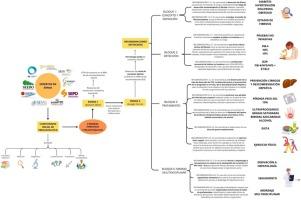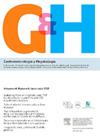Guía de práctica clínica multidisciplinar de manejo de la esteatosis hepática metabólica
IF 1.9
4区 医学
Q3 GASTROENTEROLOGY & HEPATOLOGY
引用次数: 0
Abstract
Metabolic hepatic steatosis (MetHS) is a clinically heterogeneous, multisystemic, dynamic, and complex disease, whose progression is one of the main causes of cirrhosis and hepatocarcinoma. This clinical practice guideline aims to respond to its main challenges, both in terms of disease burden and complexity. To this end, recommendations have been proposed to experts through the Delphi method. The consensus was optimal in recommendations regarding type 2 diabetes as a risk factor (1.5.1, 4.5.1), in which cases early detection of MetHS should be carried out (4.5.2). Its results also emphasize the importance of the use of non-invasive tests (FIB-4, NFS, HFS) for the exclusion of significant fibrosis in patients with suspected MetHS (2.3.1, 2.3.3). Diagnosis should be carried out through the sequential combination of non-invasive indices and transient elastography by FibroScan® for its risk stratification (2.3.3). A nearly unanimous consensus was reached regarding the role of early prevention in the impact on the quality of life and survival of patients (5.1.2), as well as on the effectiveness of the Mediterranean diet and physical exercise in relation to the improvement of steatosis, steatohepatitis and fibrosis in MetHS patients (5.2.2) and on the positive results offered by resmiterom and semaglutide in promoting fibrosis regression (5.4.1). Finally, a great consensus has been reached regarding the importance of multidisciplinary management in MetHS, for which it is essential to agree on multidisciplinary protocols for referral between levels in each health area (6.2.1), as well as ensuring that referrals to Hepatology/Digestive and Endocrinology or Internal Medicine services are effective and beneficial to prevent the risk of disease progression (6.2.3, 6.3.1).

代谢性肝脂肪变性多学科临床实践指南。
代谢性肝脂肪变性(MetHS)是一种临床异质性、多系统、动态、复杂的疾病,其进展是肝硬化和肝癌的主要原因之一。本临床实践指南旨在应对疾病负担和复杂性方面的主要挑战。为此,通过德尔菲法向专家提出了建议。2型糖尿病是一种危险因素(1.5.1,4.5.1),在这种情况下,应该进行甲氧麻黄素的早期检测(4.5.2)。研究结果还强调了使用非侵入性检查(FIB-4、NFS、HFS)排除疑似MetHS患者显著纤维化的重要性(2.3.1,2.3.3)。诊断应通过无创指标和FibroScan®瞬时弹性成像的顺序组合进行风险分层(2.3.3)。关于早期预防对患者生活质量和生存影响的作用(5.1.2),地中海饮食和体育锻炼对改善甲基甲醚患者脂肪变性、脂肪性肝炎和纤维化的有效性(5.2.2)以及瑞米瑟仑和西马鲁肽促进纤维化消退的积极结果(5.4.1),几乎达成了一致的共识。最后,关于MetHS多学科管理的重要性已经达成了很大的共识,为此,在每个卫生领域的水平之间就转诊的多学科协议达成一致是必不可少的(6.2.1),以及确保转诊到肝病学/消化和内分泌学或内科服务是有效的,有利于预防疾病进展的风险(6.2.3,6.3.1)。
本文章由计算机程序翻译,如有差异,请以英文原文为准。
求助全文
约1分钟内获得全文
求助全文
来源期刊

Gastroenterologia y hepatologia
GASTROENTEROLOGY & HEPATOLOGY-
CiteScore
1.50
自引率
10.50%
发文量
147
审稿时长
48 days
期刊介绍:
Gastroenterology and Hepatology is the first journal to cover the latest advances in pathology of the gastrointestinal tract, liver, pancreas, and bile ducts, making it an indispensable tool for gastroenterologists, hepatologists, internists and general practitioners.
 求助内容:
求助内容: 应助结果提醒方式:
应助结果提醒方式:


